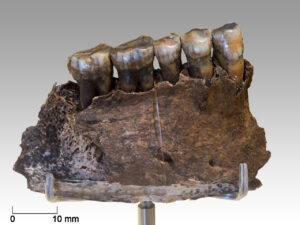WASHINGTON — Bone and tooth remnants from two Siberian caves are helping scientists for the first time decipher the social organization of our cousins the Neanderthals through genetic sleuthing, including on the remains of a father and his teenage daughter.
Researchers on Wednesday described genomic findings from the remains of 13 Neanderthals — 11 from Chagyrskaya cave and two from Okladnikov cave in the Altai Mountains of Russia — in one of the largest genetic studies of a Neanderthal population to date. The Paleolithic remains date to about 54,000 years ago.
Piecing together the relationships among some of these individuals based on the genetic findings enabled the researchers to conclude that these Neanderthal communities were composed of a small group of close relatives, consisting of perhaps 10 to 20 members, and that it was the women who migrated among communities, with the men staying put.
The caves are located at the easternmost extent of the known geographical range of Neanderthals, who inhabited parts of western Eurasia while another now-extinct human lineage called the Denisovans occupied parts of eastern Eurasia.
The caves are located within 100 kilometers of the site where the first remains of Denisovans were found, but the study detected no evidence of interbreeding between these 13 Neanderthals and Denisovans. Our species had not yet reached this region at the time.
While genomic analyses of Neanderthals have previously provided insights into their population history and close relationship to our species, their social organization has been harder to reconstruct.
“I think our insights make Neanderthals more relatable, and in some sense more human. They were people that lived and died in small family groups, likely in a harsh environment. Yet they managed to persevere for hundreds of thousands of years,” said population geneticist Benjamin Peter of the Max Planck Institute for Evolutionary Anthropology in Leipzig, Germany, a co-author of the research published in the journal Nature.
Neanderthals, more robustly built than Homo sapiens and with larger brows, lived from around 430,000 years ago to roughly 40,000 years ago.
The 13 Neanderthal individuals included five children and adolescents. There were seven males and six females.
The Chagyrskaya cave site yielded remains of an adult male father and his teenage daughter, thought to have been in late adolescence. There also was a boy between 8 and 12 years old, based on dental evidence, along with an adult female relative who the genetic findings suggested was an aunt, cousin or grandmother.
Scientists found numerous stone tools and animal bones in the two caves, suggestive of small hunter-gatherer communities whose members hunted bison, ibex, horses and other animals that migrated through the river valleys situated below these caves.
Far from the obsolete stereotype of dimwitted brutes, studies have shown that Neanderthals were intelligent, creating art, using complex group hunting methods, pigments probably for body painting, symbolic objects and perhaps spoken language.
The low genetic diversity — similar to endangered species bordering on extinction — found among the 13 Neanderthals in the research provided evidence for the small group sizes of these communities.
The researchers compared the genetic diversity on the Y-chromosome — the one inherited father-to-son — to mitochondrial DNA diversity — inherited from mothers. The higher mitochondrial genetic diversity indicated that these communities were primarily linked by movement of the females from one to another.
The nature of the interaction between our species and Neanderthals — formally called Homo neanderthalensis — remains hazy. There was interbreeding, as shown by the fact that modern non-African human populations bear residual Neanderthal DNA. But our role in their extinction remains unclear. Neanderthals disappeared relatively soon after our species moved into their territory, as was also the case with Denisovans. — Reuters























